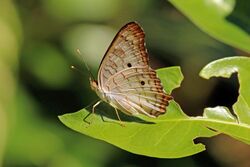Biology:Anartia jatrophae
| Anartia jatrophae | |
|---|---|

| |
| butterfly house specimen | |

| |
| A. j. jatrophae, Tobago | |
| Scientific classification | |
| Domain: | Eukaryota |
| Kingdom: | Animalia |
| Phylum: | Arthropoda |
| Class: | Insecta |
| Order: | Lepidoptera |
| Family: | Nymphalidae |
| Genus: | Anartia |
| Species: | A. jatrophae
|
| Binomial name | |
| Anartia jatrophae (Linnaeus, 1763)
| |
Anartia jatrophae, the white peacock, is a species of butterfly found in the southeastern United States , Central America, and throughout much of South America. The white peacock's larval hosts are water hyssop (Bacopa monnieri),[2][3] lemon bacopa (Bacopa caroliniensis),[4] tropical waterhyssop (Bacopa innominata),[5] frogfruit (Phyla nodiflora),[6] lanceleaf frogfruit (Phyla lanceolata),[7] and Carolina wild petunia (Ruellia caroliniana).[8][9][10] The males of the species display a unique territorial behavior, in which they stake out a territory typically 15 meters in diameter that contains larval host plants. They perch in this area and aggressively protect it from other insects and other male white peacocks.[11]
Subspecies
Seven subspecies are recognized. [12]
- A. j. guantanamo - Florida and Cuba
- A. j. intermedia - Saint Croix[13]
- A. j. jamaicensis - Jamaica
- A. j. jatrophae - South America from Venezuela to Argentina
- A. j. luteipicta - Central America from Mexico to Colombia
- A. j. saturata - Brazil
- A. j. semifusca - Puerto Rico
References
- ↑ "NatureServe Explorer 2.0 Anartia jatrophae White Peacock". https://explorer.natureserve.org/Taxon/ELEMENT_GLOBAL.2.115231/Anartia_jatrophae. Retrieved 3 October 2020.
- ↑ "Bacopa monnieri". Florida Native Plant Society. http://www.fnps.org/plants/plant/bacopa-monnieri.
- ↑ "Water Hyssop Rooted Starters". ButterflyWorx.com. 2016. http://www.butterflyworkx.com/water-hyssop.html.
- ↑ Lyn Gettys; Carl J. Della Torre III (April 2015). "Lemon bacopa: Bacopa caroliniana". UF IFAS Extension. https://edis.ifas.ufl.edu/pdffiles/AG/AG39200.pdf.
- ↑ Cary, Mary Jane (June 2015). "Planting with Purpose". The Green Gazette (Naples, FL, US: UF IFAS Extension). http://collier.ifas.ufl.edu/HomeGarden/pubs/201506GreenGazetteNewsletter.pdf. Retrieved 2017-09-01.
- ↑ "White Peacock (Anartia jatrophae)". Floridata.com LLC. 2015. https://floridata.com/tracks/butterflies/WhitePeacock.html.
- ↑ Mike Quinn. "Caterpillar Food Plants for Central Texas". Steven Schafersman. http://llanoestacado.org/resources/butterflies/caterpillar_food_plants_central_texas.pdf.
- ↑ Mark Hutchinson (2011). "Ruellia caroliniensis – Carolina Wild Petunia". Florida Native Plant Society. http://www.fnps.org/assets/pdf/pubs/ruellia_caroliniensis_carolinawildpetunia.pdf.
- ↑ "White Peacock". Florida Museum of Natural History. https://www.floridamuseum.ufl.edu/wildflower/completebutterflydata.asp?id=31.
- ↑ Lotts, Kelly; Thomas Naberhaus (2017). "White Peacock". Metalmark Web & Data. https://www.butterfliesandmoths.org/species/Anartia-jatrophae.
- ↑ Lederhouse, R.C.Expression error: Unrecognized word "et". (November 1992). "Host plant-based territoriality in the white peacock butterfly, Anartia jatrophae". Journal of Insect Behavior 5 (6): 721–728. doi:10.1007/BF01047982. ISSN 1572-8889.
- ↑ "White Peacock Anartia jatrophae". iNaturalist. https://www.inaturalist.org/taxa/49761-Anartia-jatrophae.
- ↑ "Anartia jatrophae intermedia Munroe, 1942". Butterflies of America. https://www.butterfliesofamerica.com/L/t/Anartia_jatrophae_intermedia_a.htm.
External links
Wikidata ☰ Q956166 entry
 |









